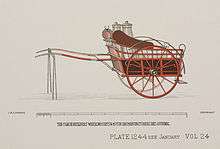Float (horse-drawn)

A float is a form of two-wheeled horse-drawn cart[1] with a dropped axle to give an especially low loadbed.
They were intended for carrying heavy or unstable items such as milk churns.[2] The name survives today in that of the milkfloat.
The axle passes beneath the loadbed of the cart but was cranked upwards at each side. This allows the load to be carried low, for stability and ease of loading with heavy objects such as churns or barrels. The high position of the stub axles allow large wheels, giving a smooth ride. The box body is open at the rear, with no more than a chain across for safety. Rather than a driving seat or box, they are driven from a standing position, alongside the load. Floats were drawn by a single horse or, especially in Ireland, a donkey.
See also
References
- ↑ James Arnold. All Drawn by Horses. David & Charles.
- ↑ Percy W Blandford (1976). Old Farm Tools and Machinery. David & Charles. ISBN 0-7153-7151-7.